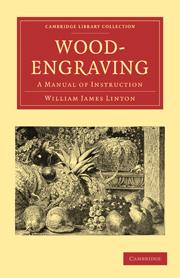Book contents
- Frontmatter
- PREFACE
- Contents
- ILLUSTRATIONS
- CHAPTER I Of engraving in relief
- CHAPTER II Of the history of Wood-Engraving
- CHAPTER III Of the difference between cutting and engraving
- CHAPTER IV Of the tools required for engraving on wood
- CHAPTER V Of drawing on wood for engraving
- CHAPTER VI Of the method of procedure in engraving
- CHAPTER VII Of things to be avoided
- CHAPTER VIII Of things to be aimed at
- CHAPTER IX Of beauty of line
- CHAPTER X Of the use and abuse of photography
- CHAPTER XI Of what constitutes an Artist
- CHAPTER XII of works for reference
- Index
- Plate section
CHAPTER XI - Of what constitutes an Artist
Published online by Cambridge University Press: 29 August 2010
- Frontmatter
- PREFACE
- Contents
- ILLUSTRATIONS
- CHAPTER I Of engraving in relief
- CHAPTER II Of the history of Wood-Engraving
- CHAPTER III Of the difference between cutting and engraving
- CHAPTER IV Of the tools required for engraving on wood
- CHAPTER V Of drawing on wood for engraving
- CHAPTER VI Of the method of procedure in engraving
- CHAPTER VII Of things to be avoided
- CHAPTER VIII Of things to be aimed at
- CHAPTER IX Of beauty of line
- CHAPTER X Of the use and abuse of photography
- CHAPTER XI Of what constitutes an Artist
- CHAPTER XII of works for reference
- Index
- Plate section
Summary
NOTWITHSTANDING all that has been already said of the indispensable qualifications of an artist, I may venture on some farther words, to clinch what I have been hoping to drive into the minds of my readers desirous of learning the art of engraving in wood.
Let it not be thought contradictory if I again remark that an exact boundary-line between skilled mechanism and art is hardly to be obtained. The mechanic may have in himself, and express in his work, so much of taste and understanding that we dare not absolutely deny him the name of artist. The acknowledged artist may do what seems only mechanical, and yet in that give evidence of his artistic quality. There is no such thing as absolutely distinct classification. We can but classify broadly, admitting exceptions. Bearing this in mind, we may take extremes to illustrate our argument.
Here are two specimens of purely mechanical work: The clean cutting is by a skilled workman. The lines of themselves speak for him. They are true. He has cut them as drawn. We can but take his word, or this his mark, as sufficient evidence that the draughtsman so drew them. The unclean cutting is the work of an unskilled workman, or the unskilful work of the workman whatever his capacity. He can not make us believe in the truth of this work. No man could have drawn the lines as they appear here. He, the “engraver,” perhaps did not even see the lines drawn for him.
- Type
- Chapter
- Information
- Wood-EngravingA Manual of Instruction, pp. 103 - 116Publisher: Cambridge University PressPrint publication year: 2010First published in: 1884

